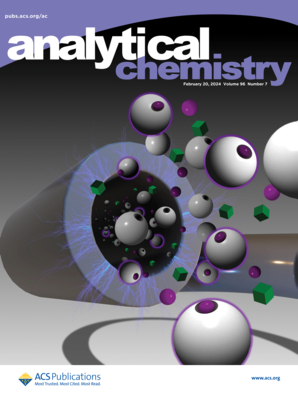研究影响氢/氘交换质谱法中数据独立获取方法性能的仪器因素
IF 6.7
1区 化学
Q1 CHEMISTRY, ANALYTICAL
引用次数: 0
摘要
本文章由计算机程序翻译,如有差异,请以英文原文为准。

Examining Instrumental Factors Influencing the Performance of Data-Independent Acquisition Methods in Hydrogen/Deuterium Exchange Mass Spectrometry
Hydrogen/deuterium exchange mass spectrometry (HX-MS) is a method used to study solution-phase protein structure and dynamics. Despite its many applications, HX-MS is limited in throughput because manual data analysis is still the norm. We previously developed HX-MS2 technology to add a second dimension of deuteration data and promote automated data processing. Data-independent acquisition (DIA) techniques enable this approach, but we require optimized methods for best performance. Using an Orbitrap Eclipse for illustration, we show that ion optics and collision energy settings typical of a proteomics DIA experiment generate maximal peptide retrieval from the DIA library. As few as three MS2 sequence ions are sufficient to generate a deuteration measurement with a precision that exceeds what is possible in traditional HX-MS. DIA window sizes are based on the chromatographic resolution of the method. An inter-scan window offset method is the recommended default configuration for most HX-DIA applications butan intra-scan overlap method can be tuned for highest performance and is recommended when maximum peptide retrieval is desired. We demonstrate the robustness of one HX-MS2 configuration (consisting of Trajan HDX automation technology, an Orbitrap Eclipse mass spectrometer and AutoHX software) on an extensive time-course analysis of phosphorylase B and an epitope analysis of single-domain antibodies (VHHs, nanobodies) specific to the receptor binding domain of SARS-CoV-2 spike protein.
求助全文
通过发布文献求助,成功后即可免费获取论文全文。
去求助
来源期刊

Analytical Chemistry
化学-分析化学
CiteScore
12.10
自引率
12.20%
发文量
1949
审稿时长
1.4 months
期刊介绍:
Analytical Chemistry, a peer-reviewed research journal, focuses on disseminating new and original knowledge across all branches of analytical chemistry. Fundamental articles may explore general principles of chemical measurement science and need not directly address existing or potential analytical methodology. They can be entirely theoretical or report experimental results. Contributions may cover various phases of analytical operations, including sampling, bioanalysis, electrochemistry, mass spectrometry, microscale and nanoscale systems, environmental analysis, separations, spectroscopy, chemical reactions and selectivity, instrumentation, imaging, surface analysis, and data processing. Papers discussing known analytical methods should present a significant, original application of the method, a notable improvement, or results on an important analyte.
 求助内容:
求助内容: 应助结果提醒方式:
应助结果提醒方式:


